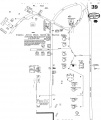Stonewall Jackson Manual Training and Industrial School
| Stonewall Jackson Manual Training and Industrial School | |
|---|---|
 | |
| Established | 1907 |
| Opened | 1909 |
| Current Status | Active |
| Building Style | Cottage Plan |
| Architect(s) | Louis H. Asbury |
| Location | Concord, NC |
| Architecture Style | Colonial Revival |
| Alternate Names |
|
History[edit]
In late nineteenth-century North Carolina, young men convicted of criminal offenses were subjected to the same harsh sentences and punishments as hardened adult criminals. In 1890 James P. Cook, a resident of Concord and editor of the local daily newspaper, the Standard, witnessed a sentence of "three years and six months at hard labor on the Cabarrus County Chain Gang" imposed on a 13-year-old boy convicted of petty theft. Distressed at the sight of the lad taken from the courtroom chained to a convicted adult criminal, Cook devoted the next 17 years to a campaign for the establishment of a training school for boys.
Supporters of such a school, particularly the benevolent organization King's Daughters of North Carolina, finally convinced the state legislature to embrace their "radical" idea. A special committee of the King's Daughters in 1906 successfully campaigned for the school through public meetings, newspaper articles and editorials, and the dissemination of pamphlets describing the success of reformatories in other states. Success in the legislature was finally assured when sponsors of the bill gained the support of the Confederate veterans in the General Assembly, proposing that the new institution be named in honor of beloved Confederate general Thomas J. "Stonewall" Jackson, who died during the Battle of Chancellorsville. The act establishing the Stonewall Jackson Manual Training and Industrial School in Concord became law on 2 March 1907.
Governor R. B. Glenn named James P. Cook to the school's first board of trustees. The board then elected Cook as its chairman, a position he held for almost two decades. At a public meeting in Concord on 30 Sept. 1907, the citizens of Cabarrus County appointed a committee to raise funds and locate land to be donated to the training school trustees to secure placement of the new school within Cabarrus County. The fund-raising effort was successful, and the school was located on a site that is now within the Concord city limits. In November 1907, the executive committee of the trustees named Professor Walter Thompson, then superintendent of Concord public schools, the first superintendent of instruction at Stonewall Jackson Training School.
Boys were generally incarcerated for relatively minor scrapes with the law, including school truancy. he General Assembly only allocated a meager $10,000 to the project over a two year period. Unable to purchase a parcel of land adequate for the school, the Board of Trustees reached out to North Carolina communities. Citizens of Concord became interested in the project and raised another $10,000 to purchase a 288 acre tract of land in Cabarrus County. A generous $5,000 donation from the King’s Daughters and North Carolina Federation of Women’s Clubs enabled the construction of two cottages on the property. Construction costs for the first cottage exhausted funds to the point where it could not be properly outfitted. James Cook’s wife took it upon herself to rally local businesses and charitable individuals to donate furnishings and amenities. On January 12, 1909 the school housed its first students and staff in the newly completed King’s Daughters Cottage.
Within a relatively short span of time the school was able to overcome its foundational hardships. Word spread throughout the state that the school had positive outcomes in turning the lives of boys around. As a result the campus rapidly expanded over the next three decades. State funds, support from surrounding counties, and private donations supported the construction of a total of 17 colonial revival style cottages. In 1922 the administration was thoroughly destroyed in a fire. In its stead rose the Cannon Memorial Memorial Hall on the north side of the property. By the 1940′s additional buildings included a gymnasium, pool, infirmary, bakery, laundry, print shop, and other smaller structures.
Legislative policy eventually shifted away from the incarceration of juvenile offenders found guilty of "status" offenses such as truancy and undisciplined behavior. As a result, the Stonewall Jackson population had dwindled by the early 2000s to an average of 150 young men, from a peak population of 500 juveniles at the school's zenith. The crimes committed by juveniles confined at the school tend to be much more violent than 20 years ago; many are drug- and weapons-related offenses. Consequently, a fence has been installed to prevent students from leaving the grounds.
In 1999, a fifteen-year battle between the school’s administrators and historic preservationists over several of the institution’s buildings ended. School administrators agreed to help preserve some of the oldest campus buildings if allowed to demolish other derelict buildings on the property. [1]




